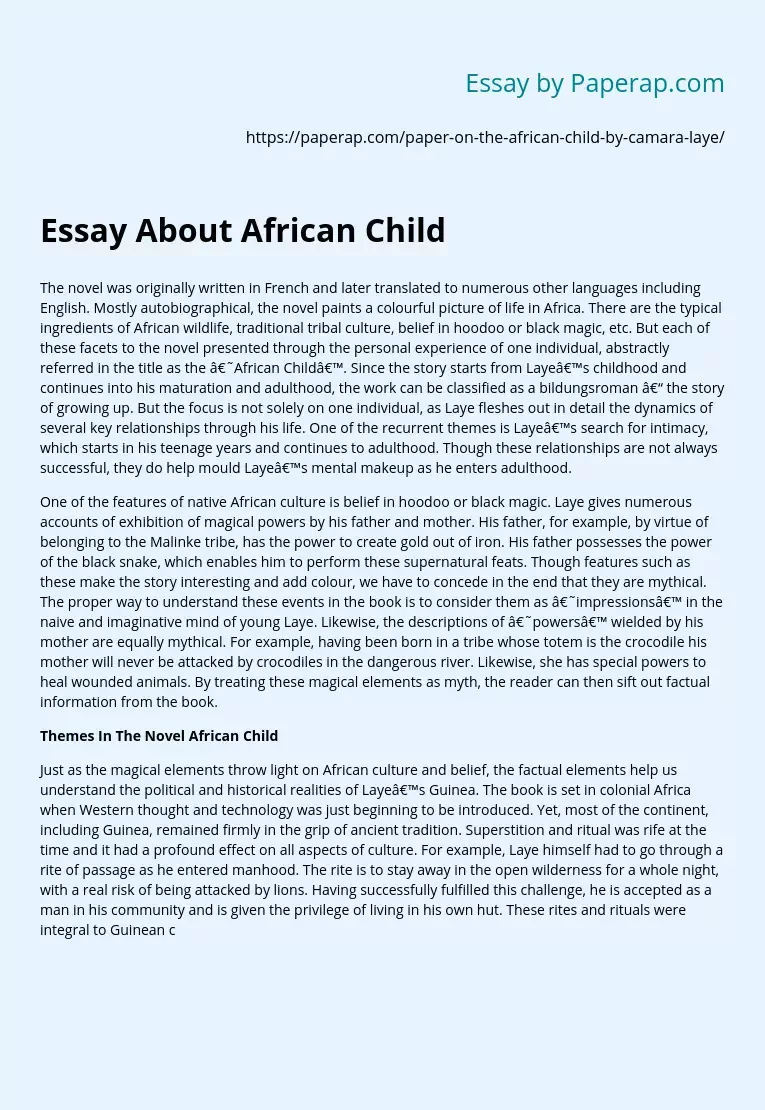Essay About African Child
The novel was originally written in French and later translated to numerous other languages including English. Mostly autobiographical, the novel paints a colourful picture of life in Africa. There are the typical ingredients of African wildlife, traditional tribal culture, belief in hoodoo or black magic, etc. But each of these facets to the novel presented through the personal experience of one individual, abstractly referred in the title as the ‘African Child’. Since the story starts from Laye’s childhood and continues into his maturation and adulthood, the work can be classified as a bildungsroman – the story of growing up.
But the focus is not solely on one individual, as Laye fleshes out in detail the dynamics of several key relationships through his life. One of the recurrent themes is Laye’s search for intimacy, which starts in his teenage years and continues to adulthood. Though these relationships are not always successful, they do help mould Laye’s mental makeup as he enters adulthood.
One of the features of native African culture is belief in hoodoo or black magic. Laye gives numerous accounts of exhibition of magical powers by his father and mother. His father, for example, by virtue of belonging to the Malinke tribe, has the power to create gold out of iron. His father possesses the power of the black snake, which enables him to perform these supernatural feats. Though features such as these make the story interesting and add colour, we have to concede in the end that they are mythical.
The proper way to understand these events in the book is to consider them as ‘impressions’ in the naive and imaginative mind of young Laye. Likewise, the descriptions of ‘powers’ wielded by his mother are equally mythical. For example, having been born in a tribe whose totem is the crocodile his mother will never be attacked by crocodiles in the dangerous river. Likewise, she has special powers to heal wounded animals. By treating these magical elements as myth, the reader can then sift out factual information from the book.
Themes In The Novel African Child
Just as the magical elements throw light on African culture and belief, the factual elements help us understand the political and historical realities of Laye’s Guinea. The book is set in colonial Africa when Western thought and technology was just beginning to be introduced. Yet, most of the continent, including Guinea, remained firmly in the grip of ancient tradition. Superstition and ritual was rife at the time and it had a profound effect on all aspects of culture. For example, Laye himself had to go through a rite of passage as he entered manhood. The rite is to stay away in the open wilderness for a whole night, with a real risk of being attacked by lions. Having successfully fulfilled this challenge, he is accepted as a man in his community and is given the privilege of living in his own hut. These rites and rituals were integral to Guinean culture, even as Western methods of agricultural production and social organization were being implemented. These opposing tendencies were depicted well in the book.
I think there are a lot of positive features in the book. Firstly, translators James Kirkup and Ernest Jones have done a stellar job of rendering the original French version into English. The translator’s major accomplishment is in being able to retain the ‘authorial voice’ of Laye across languages. The style of presentation and the manner of sentence construction highly resemble the original. This way we are made aware that the narrator is someone who is not a native speaker of English. This lends a quality of authenticity to the text. Second, the choice of topics and themes dealt by the book is very discreet. Camara Laye strikes a good balance between socio-historical commentary and autobiography. This juxtaposition works well for the book, as the author succeeds in bringing impersonal tone to his analysis and judgment.
Coming to one of the few drawbacks, it would be imprudent for students to think of ‘The African Child’ as factually accurate at all places. For reasons of literary and artistic licence there are instances where fact merges into the realm of the fiction. So, the scholarly merit of the work will have to be weighed in this light. Barring such small drawbacks, I would recommend this book for students of African history, politics and culture. A kaleidoscopic view of all these subjects is presented through the prism of one individual’s life, namely, the author himself. The time from Laye’s infancy to his adulthood offers a representative snapshot of early twentieth century Africa. The book is rich in detail, colourful in its perspectives and insightful in its socio-cultural analysis.
Works Cited:
Laye, Camara, The Dark Child: The Autobiography of an African Boy, Published by Farrar, Straus and Giroux, 1954, pp.192, ISBN: 080901548X
Essay About African Child. (2019, Dec 05). Retrieved from https://paperap.com/paper-on-the-african-child-by-camara-laye/

